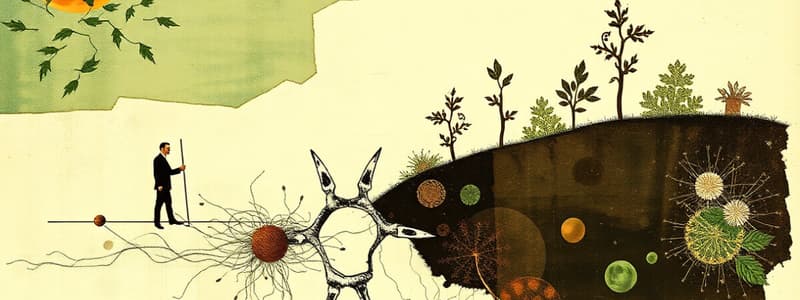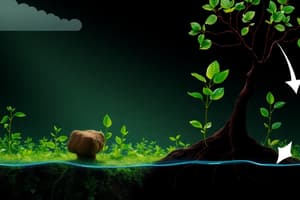Podcast
Questions and Answers
What process involves plants absorbing carbon dioxide during the day and releasing it at night?
What process involves plants absorbing carbon dioxide during the day and releasing it at night?
- Photosynthesis
- Decomposition
- Photorespiration (correct)
- Combustion
What happens to carbon when animals consume plants?
What happens to carbon when animals consume plants?
- It is completely lost to the atmosphere
- It is converted to methane
- It is expelled as oxygen
- It is absorbed and stored in their tissues (correct)
Which process describes the release of carbon back into the environment after the death of an animal?
Which process describes the release of carbon back into the environment after the death of an animal?
- Decomposition (correct)
- Oxidation
- Fermentation
- Respiration
When carbon is stored in the soil after the death of plants, what can it eventually become?
When carbon is stored in the soil after the death of plants, what can it eventually become?
What is the process called when carbon is released into the atmosphere by burning coal or gas?
What is the process called when carbon is released into the atmosphere by burning coal or gas?
What is the first step in the carbon cycle as described?
What is the first step in the carbon cycle as described?
What happens during the process of decomposition in the carbon cycle?
What happens during the process of decomposition in the carbon cycle?
Which process describes the transformation of organic matter into coal or gas?
Which process describes the transformation of organic matter into coal or gas?
In what state is carbon before it is released by animals during respiration?
In what state is carbon before it is released by animals during respiration?
What is the role of combustion in the carbon cycle?
What is the role of combustion in the carbon cycle?
Flashcards
Photosynthesis
Photosynthesis
Plants absorb carbon dioxide from the atmosphere during daylight.
Feeding
Feeding
Animals obtain carbon by consuming plants.
Decomposition
Decomposition
Decomposers return carbon to the environment when organisms die.
Fossil Fuels
Fossil Fuels
Signup and view all the flashcards
Combustion
Combustion
Signup and view all the flashcards
Photorespiration
Photorespiration
Signup and view all the flashcards
Carbon Movement
Carbon Movement
Signup and view all the flashcards
Decomposers' Role
Decomposers' Role
Signup and view all the flashcards
Fossil Fuel Formation
Fossil Fuel Formation
Signup and view all the flashcards
Combustion's Impact
Combustion's Impact
Signup and view all the flashcards
Study Notes
Carbon Cycle Overview
- Carbon cycles through the environment, constantly being removed and restored.
- Plants absorb carbon dioxide during the day, a process called photosynthesis.
- Plants release carbon dioxide at night.
- Animals acquire carbon when they consume plants (feeding).
- Carbon returns to the environment when animals die (decomposition).
- When plants die, carbon can be incorporated into soil, eventually forming fossil fuels (coal, gas).
- Burning fossil fuels releases carbon back into the atmosphere (combustion).
Studying That Suits You
Use AI to generate personalized quizzes and flashcards to suit your learning preferences.




